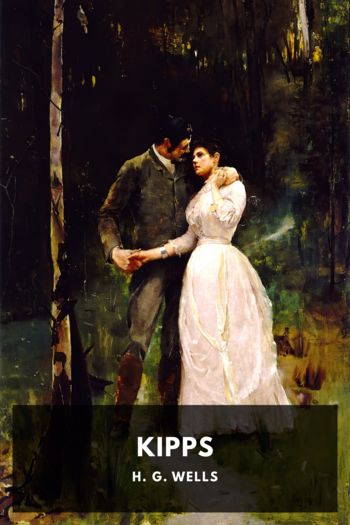Kipps, H. G. Wells [uplifting book club books TXT] 📗

- Author: H. G. Wells
Book online «Kipps, H. G. Wells [uplifting book club books TXT] 📗». Author H. G. Wells
Thence they passed to the alternative of service lifts, and then by an inspiration of the architect to the possibilities of gas heating. Kipps did a complicated verbal fugue on the theme, “gas heating heats the air,” with variable aspirates; he became very red and was lost to the discussion altogether for a time, though his lips kept silently on.
Subsequently the architect wrote to say that he found in his notebook very full and explicit directions for bow windows to all rooms, for bedrooms, for water supply, lift, height of stairs and absence of twists therein, for a well-ventilated kitchen twenty feet square, with two dressers and a large box-window seat, for scullery and outhouses and offices, but nothing whatever about drawing-room, dining-room, library or study, or approximate cost, and he awaited further instructions. He presumed there would be a breakfast-room, dining-room, drawing-room, and study for Mr. Kipps, at least that was his conception, and the young couple discussed this matter long and ardently.
Ann was distinctly restrictive in this direction. “I don’t see what you want a drawin’-room and a dinin’ and a kitchen for. If we was going to let in summer—well and good. But we’re not going to let. Consequently we don’t want so many rooms. Then there’s a ’all. What use is a ’all? It only makes work. And a study!”
Kipps had been humming and stroking his moustache since he had read the architect’s letter. “I think I’d like a little bit of a study—not a big one, of course, but one with a desk and bookshelves, like there was in Hughenden. I’d like that.”
It was only after they had talked to the architect again and seen how scandalised he was at the idea of not having a drawing-room that they consented to that Internal Feature. They consented to please him. “But we shan’t never use it,” said Ann.
Kipps had his way about a study. “When I get that study,” said Kipps, “I shall do a bit of reading I’ve long wanted to do. I shall make a habit of going in there and reading something an hour every day. There’s Shakespeare and a lot of things a man like me ought to read. Besides, we got to ’ave somewhere to put the Encyclopædia. I’ve always thought a study was about what I’ve wanted all along. You can’t ’elp reading if you got a study. If you ’aven’t, there’s nothing for it, so far’s I can see, but treshy novels.”
He looked down at Ann and was surprised to see a joyless thoughtfulness upon her face.
“Fency, Ann!” he said, not too buoyantly, “ ’aving a little ’ouse of our own!”
“It won’t be a little ’ouse,” said Ann, “not with all them rooms.”
Any lingering doubt in that matter was dispelled when it came to plans.
The architect drew three sets of plans on a transparent bluish sort of paper that smelt abominably. He painted them very nicely; brick red and ginger, and arsenic green and a leaden sort of blue, and brought them over to show our young people. The first set were very simple, with practically no External Features—“a plain style,” he said it was—but it looked a big sort of house nevertheless; the second had such extras as a conservatory, bow windows of various sorts, one roughcast gable and one half-timbered ditto in plaster, and a sort of overhung verandah, and was much more imposing; and the third was quite fungoid with External Features, and honeycombed with Internal ones; it was, he said, “practically a mansion,” and altogether a very noble fruit of the creative mind of man. It was, he admitted, perhaps almost too good for Hythe; his art had run away with him and produced a modern mansion in the “best Folkestone style”; it had a central hall with a staircase, a Moorish gallery, and Tudor stained glass window, crenelated battlements to the leading over the portico, an octagonal bulge with octagonal bay windows, surmounted by an oriental dome of metal, lines of yellow bricks to break up the red and many other richnesses and attractions. It was the sort of house, ornate and in its dignified way voluptuous, that a city magnate might build, but it seemed excessive to the Kippses. The first plan had seven bedrooms, the second eight, the third eleven; that had, the architect explained, “worked in” as if they were pebbles in a mountaineer’s boat.
“They’re big ’ouses,” said Ann directly the elevations were unrolled.
Kipps listened to the architect with round eyes and an exuberant caution in his manner, anxious not to commit himself further than he had done to the enterprise, and the architect pointed out the Features and other objects of interest with the scalpel belonging to a pocket manicure set that he carried. Ann watched Kipps’ face and communicated with him furtively over the architect’s head. “Not so big,” said Ann’s lips.
“It’s a bit big for what I meant,” said Kipps, with a reassuring eye on Ann.
“You won’t think it big when you see it up,” said the architect; “you take my word for that.”
“We don’t want no more than six bedrooms,” said Kipps.
“Make this one a box-room, then,” said the architect.
A feeling of impotence silenced Kipps for a time.
“Now which,” said the architect, spreading them out, “is it to be?”
He flattened down the plans of the most ornate mansion to show it to better effect.
Kipps wanted to know how much each would cost “at the outside,” which led to much alarmed signalling from Ann. But the architect could estimate only in the most general way.
They





Comments (0)